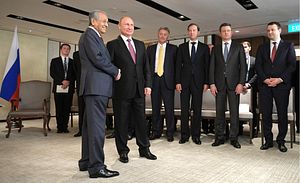The 33rd ASEAN Summit and its related meetings recently concluded in Singapore. The annual regional meeting attracted lots of national leaders to the Lion City, among which were Russian President Vladimir Putin and Malaysian Prime Minister Mahathir Mohamad. Notably, Putin was the second leader that Mahathir held a bilateral meeting with, following only a summit with the host, Singapore Prime Minister Lee Hsien Loong. Putin also chose to meet Mahathir just after his own meeting with Singapore President Halimah Yacob. Considering both countries’ common interests on fighter jets and trade as well as signals sent from the meeting, it is expected that Malaysia and Russia will seek deeper cooperation on defense and economics in the future.
Malaysia currently owns a total of 28 Russian military aircraft. Of those, 18 Su-30MKM jets were purchased by the previous government in 2003 and entered into service in two batches in 2007 and 2009. The other 10 are MiG-29 fighters that started their services in Royal Malaysian Air Force (RMAF) in 1994-1995. Last year, when Prime Minister Najib Razak was still holding the government, a $2 billion aircraft purchase plan was unveiled, aiming at replacing the 15-year-old MiG-29s. However, the purchase was temporarily suspended after Mahathir’s surprised win in the 2018 general election. After the new government was established, several RMAF plans, including this $2 billion purchase, were announced as being on hold due to budget constraints. But later, newly appointed Defense Minister Mohamad Sabu complained that only four out of the 28 Russian fighter jets are currently operational. Apparently, there is a strong need for addition military aircraft for Malaysia, either through learning how to repair the RMAF’s existing jets or buying new jets.
In terms of repairing and upgrading, approaching Russia – the original manufacturer — is the only option for Mahathir and his Pakatan Harapan (PH) government. What’s more, it seems that Mahathir is inclined to do this, since he reportedly told Putin that Malaysia would like to learn how to maintain and repair the aircraft.
Military-technical cooperation between Russia and Malaysia started in 1994 and deepened when the Russia-Malaysian Intergovernmental Commission was formed in 1999. If Malaysia decides to seek additional help from Russia on fighter maintenance, various exchanges and communications, from techniques to expertise exchanges, will be implemented between the two countries more regularly. Furthermore, the idea to jointly develop military hardware, as proposed in 2016, may get a chance to be rekindled.
If Mahathir instead decides to resume the RMAF purchase plan, Russia’s MiG-35 is among the options, together with France’s Rafale and Britain’s Eurofighter Typhoon. However, the Rafale is much more expensive than MiG-35 — the price of one Rafale ($130 million) can cover at least two MiG-35 ($55 million per jet), and that’s not even mentioning the Eurofighter Typhoon, which is more expensive than Rafale at $175 million per jet. While improving defense capability is important for the new governing coalition in Malaysia, controlling and reducing the huge government deficit is the top priority; to that end, the PH government has already suspended several infrastructure megaprojects. That means the government will likely go for the cheaper option if it decides to pursue new fighters. According to Bernama, Malaysia’s state news agency, Putin also told Mahathir that Russia is interested in making a deal to sell aircraft to Malaysia.
Besides defense, the Mahathir-Putin meeting naturally touched on how to deepen trade ties between the two countries. In recent years, Russia has emphasized developing non-oil export-oriented industries, with efforts such as the launch of the Russian Export Center in 2015. Malaysia has been pursuing export-oriented industrialization for decades and bolstering trade is a part of the development strategy released by Pakatan Harapan.
There is certainly room for growth in their bilateral trade relationship. Malaysia is not within the top trading partners of Russia and vice versa. Moreover, according to OEC database, over half the export in goods from Malaysia to Russia are machines and over 70 percent of goods from Russia to Malaysia are mineral products, signaling that there is large room for both countries to diversify their trade cooperation. However, this is not the first time that leaders of the two countries agreed to expand their trade — on the sidelines of APEC in 2012, Putin and Najib discussed trade expansion. Nevertheless, the total trade volume increased very slowly over the next four years, from $1.769 billion to only $2.19 billion in 2016. Challenges and opportunities go hand in hand for Malaysia-Russia trade.
Mahathir is known to be keen to diversify his country’s foreign relations and he has been playing balance-of-power policies among great powers for decades. Russia, with its strong military, is definitely one of the great powers that Mahathir will try to connect with. Meanwhile, Russia’s relationship with the West has not been smooth in recent years, meaning that getting along well with countries in Asia, especially Southeast Asia, seems to be increasingly important in Russia’s foreign policy. That’s also probably the reason why Putin attended the East Asia Summit as an official participant for the first time this year (he had previously attended the first EAS in 2005 as a guest). Under such circumstances, Malaysia is of course a country that Russia would like to deepen relations with. Not only is Malaysia the third largest economy in Southeast Asia, but the country’s new prime minister is famous for criticizing the West.
As a result, deepening their bilateral relation is of common interest for both Malaysia and Russia. Cooperation on defense and trade are the most possible steps forward, according to their own national interests.
Li Xirui is a research assistant at the China-ASEAN Research Institute at Guangxi University, China.

































